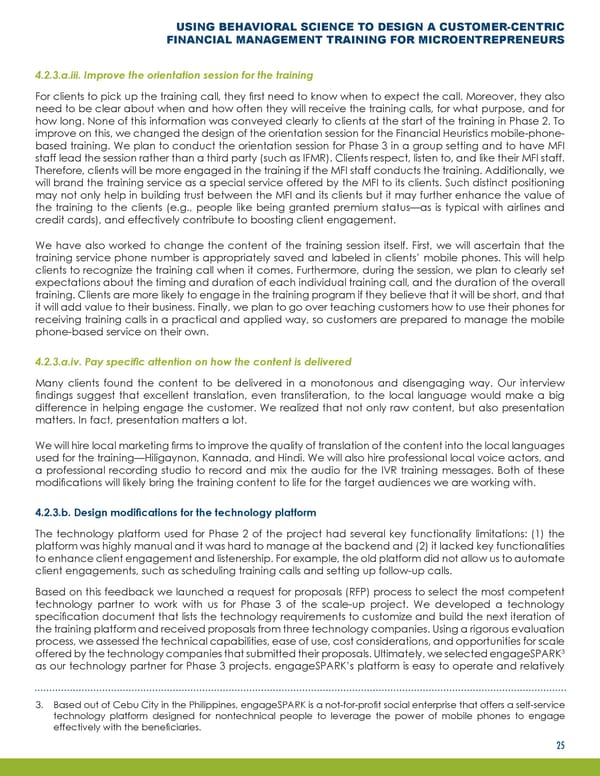USING BEHAVIORAL SCIENCE TO DESIGN A CUSTOMER-CENTRIC FINANCIAL MANAGEMENT TRAINING FOR MICROENTREPRENEURS 4.2.3.a.iii. Improve the orientation session for the training For clients to pick up the training call, they first need to know when to expect the call. Moreover, they also need to be clear about when and how often they will receive the training calls, for what purpose, and for how long. None of this information was conveyed clearly to clients at the start of the training in Phase 2. To improve on this, we changed the design of the orientation session for the Financial Heuristics mobile-phone- based training. We plan to conduct the orientation session for Phase 3 in a group setting and to have MFI staff lead the session rather than a third party (such as IFMR). Clients respect, listen to, and like their MFI staff. Therefore, clients will be more engaged in the training if the MFI staff conducts the training. Additionally, we will brand the training service as a special service offered by the MFI to its clients. Such distinct positioning may not only help in building trust between the MFI and its clients but it may further enhance the value of the training to the clients (e.g., people like being granted premium status—as is typical with airlines and credit cards), and effectively contribute to boosting client engagement. We have also worked to change the content of the training session itself. First, we will ascertain that the training service phone number is appropriately saved and labeled in clients’ mobile phones. This will help clients to recognize the training call when it comes. Furthermore, during the session, we plan to clearly set expectations about the timing and duration of each individual training call, and the duration of the overall training. Clients are more likely to engage in the training program if they believe that it will be short, and that it will add value to their business. Finally, we plan to go over teaching customers how to use their phones for receiving training calls in a practical and applied way, so customers are prepared to manage the mobile phone-based service on their own. 4.2.3.a.iv. Pay specific attention on how the content is delivered Many clients found the content to be delivered in a monotonous and disengaging way. Our interview findings suggest that excellent translation, even transliteration, to the local language would make a big difference in helping engage the customer. We realized that not only raw content, but also presentation matters. In fact, presentation matters a lot. We will hire local marketing firms to improve the quality of translation of the content into the local languages used for the training—Hiligaynon, Kannada, and Hindi. We will also hire professional local voice actors, and a professional recording studio to record and mix the audio for the IVR training messages. Both of these modifications will likely bring the training content to life for the target audiences we are working with. 4.2.3.b. Design modifications for the technology platform The technology platform used for Phase 2 of the project had several key functionality limitations: (1) the platform was highly manual and it was hard to manage at the backend and (2) it lacked key functionalities to enhance client engagement and listenership. For example, the old platform did not allow us to automate client engagements, such as scheduling training calls and setting up follow-up calls. Based on this feedback we launched a request for proposals (RFP) process to select the most competent technology partner to work with us for Phase 3 of the scale-up project. We developed a technology specification document that lists the technology requirements to customize and build the next iteration of the training platform and received proposals from three technology companies. Using a rigorous evaluation process, we assessed the technical capabilities, ease of use, cost considerations, and opportunities for scale 3 offered by the technology companies that submitted their proposals. Ultimately, we selected engageSPARK as our technology partner for Phase 3 projects. engageSPARK’s platform is easy to operate and relatively 3. Based out of Cebu City in the Philippines, engageSPARK is a not-for-profit social enterprise that offers a self-service technology platform designed for nontechnical people to leverage the power of mobile phones to engage effectively with the beneficiaries. 25
 Using Behavioral Science to Design a Customer-Centric Financial Management Training for Microentrepreneurs Page 27 Page 29
Using Behavioral Science to Design a Customer-Centric Financial Management Training for Microentrepreneurs Page 27 Page 29